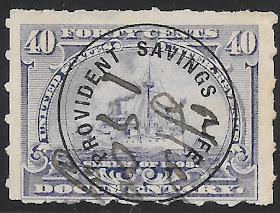Philatelic Literature Review
Though Richard Fullerton published in 1952
what has been the definitive list of 1898 documentary printed cancels, there
have been other distinguished philatelists that have contributed to the field,
and whose work predated and ran concurrently to the work of Fullerton. Clarence Chappell, who produced an extensive
list of the printed cancels on 1898 proprietaries, published a list of their
documentary counterparts in the Weekly Philatelic Gossip in 1942. And a contemporary of Mr. Fullerton, Charles
Metz, published lists of these cancels in Chambers Stamp Journal in the late
1940s and early 50s.
Chappell's format, similar to his proprietary list
that was eventually updated by Joyce
Clarence Chappell, Weekly Philatelic
Gossip, 1942. Precanceled 1898 Documentaries: The
Railroad Companies. This article appears to be the
first published list in philatelic literature of the 1898 documentary printed
cancels. Chappell confines the list to
railroads only. He includes all of the
railroads in Fullerton’s 1952 list except for the Chicago, Burlington &
Northern RR, the Chicago, Fort Madison & Des Moines RR, the Kansas City
& Northwestern RR, and the Sioux City & Pacific RY. His format is identical to his better known
1898 proprietary printed cancel list. As
of 1942 it is clear that much discovery was still ahead for these cancels, as
Chappell is not only missing four of the railroads in Fullerton’s list, but
many of the 2 cent stamps and cancel varieties.
The Bureau Specialist, November 1946: This is a stub of an article
in which Gilmore E. Martin, Bureau Isssues Association Member #231, reports
having the 10 cent documentary battleship precanceled C.M.&St.P.Ry by the Chicago, Milwaukee
& St. Paul Railway. The same Mr.
Gilmore reports knowing of a collector in St. Charles, Missouri who has the
same 10 cent stamp precanceled I.&G.N.R.R. by the International and Great
Northern Railroad and used on an export bill of lading. Neither of these stamps were accounted for in
Chappell’s 1942 list.
Fullerton List (with addendum). In 1972, Eric Jackson reprinted the list,
including a one page addendum that Fullerton added soon after the original list
was printed.
Fullerton Article in Linn’s, 1952. Railroads
on Battleships.
This article in Linn’s Stamp News appeared in a special “Precancel
Edition”. Richard Fullerton was a member
of the Precancel Stamp Society, and showed his collecting
interests in this article. While his
list was published devoid of subjective commentary, the Linn’s article is a
cheerleading piece, written to cultivate interest in collecting 1898
documentary precancels, specifically those made by railroads.
Charles Metz, Chambers Stamp Journal, 1948
and 1952. It
appears that Charles Metz was engaged in collecting and documenting the users,
types and varieties of 1898 documentary printed cancels around the same time as
Richard Fullerton, publishing his work in the Chambers Stamp Journal and then
having articles republished in the The American Revenuer. It appears that Metz’s first effort came in
1948, titled simply, Check List of
Railroad Revenue Precancels. This
list omits the Chicago, Burlington & Northern RR and the Kansas City &
North Western RR that are included in the Fullerton List. By 1951, Metz published a follow-up list in
Chambers Stamp Journal, continuing to omit the two previously mentioned
railroads but including the I&GNRR 10 cent which was not included in his
1948 list, nor in Fullerton’s list.
Notably, Metz quotes the collector D. S. Tierney, regarding the
existence of the Chicago, Fort Madison & Des Moines RR cancel. Tierney reported in 1951 having this cancel
on a Chicago, Burlington & Quincy RR bill of Lading. Tierney added that the CFM&DMRR was a
short line that ran from Fort Madison, Iowa, northwest to a junction with the
CB&QRR near Batavia, which was 12 miles from where Tierney lived. The CFM&DMRR is one of the rarest of all
the railroad printed cancels; it may be that the known copy was removed from
Mr. Tierney’s bill of lading.
Richard Friedberg, Linn’s, Printed
Cancels on Documentaries are Scarce, 1985. In this short article in Linn’s Stamp News, Friedberg
provides a “scarcity rating” to the most common variety of cancel used by each
railroad in the Fullerton list. Using a
scale from 1 to 5, more commonly seen cancels like those of the CB&QRR and
I&GNRR are given a 1, while the scarcest like the Chicago, Fort Madison
& Des Moines Railroad are assigned a 5.
Varieties and the rarer items among the railroads, like cancels on the 2
cent documentary, are not included in his index. Those ratings are included in the appendix of
this volume. At the end of the column,
the existence of the T.S.E.RY. cancel is mentioned, though the railroad is not
among those included in the scarcity index. Richard Friedberg had a long
running column in Linn’s Stamp News in which 85 of his columns were collected
into the book Introduction to United
States Revenue Stamps. The column
dedicated to 1898 documentary printed cancels did not make the book.
Ron Lesher, Stamp Collector & Dealer,
2021. Lesher’s
article is dedicated to the International & Great Northern Railroad’s
printed cancels. The I&GNRR used
more denominations on which to pre-print cancels than any other railroad;
Lesher provides examples of all those denominations, including the 1, 2, 5, and
10 cent battleship stamps, the 1c green R154, and adds the I&GNRR’s
battleship 1 cent precancel handstamp, which Fullerton included in his list. Both the CM&StPRy and the I&GNRR used
the 10 cent documentary for foreign bills of lading. The CM&StPRy undoubtedly had cargo that
was exported to Canada, while the I&GNRR, Lesher notes, met the National
Railway of Mexico at the Texas border city of Laredo.





















































